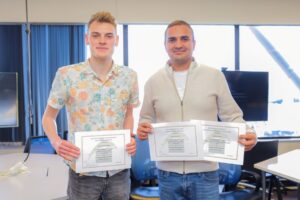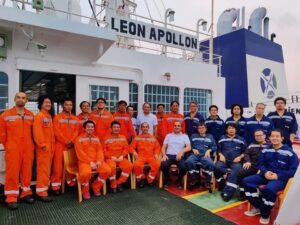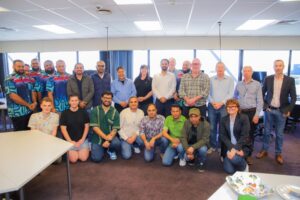The captain of an oil tanker has been judged best theoretical and best practical Master’s student at the MIT New Zealand Maritime School’s annual prizegiving.
Sudershan Kant won both main awards for the Diploma of Foreign Going Master – Class of 2025 at the prizegiving held on Friday 17 October.

Overall Excellence Award winners were (left) Jackson Kynan-Wilde in the Diploma in Nautical Science and Sudershan Kant in the Diploma of Foreign Going Master (right).
The other main winner was Jackson Kynan-Wilde who won the Overall Excellence Award for the Diploma in Nautical Science – Class of 2025. Both academic marks in the theory classes and performance in the simulation centre were considered in determining this award.
Having studied in other institutions around the world, Captain Kant says that the learning experience at MIT stands out as ‘exceptionally well-organised, practical, and industry-focused’.
“The balance between theoretical knowledge and practical application has helped all students to gain a much deeper understanding of maritime operations and leadership responsibilities.
“The integration of case studies, and real-world scenarios and simulator training makes the learning process both engaging and highly relevant to modern maritime standards.
“The dedication and professionalism of the instructors combined with the school’s emphasis on safety, competence, and discipline have made this programme truly outstanding. I believe it sets a benchmark for maritime education.”

Captain Kant (sitting with white shirt) served as the Captain and Chief Officer on the 228-metre oil tanker Leon Apollon.
Kees Buckens, Industry Engagement and Simulation Manager for the NZ Maritime School, says ākonga came from all over the world to complete the Master’s programme.
“Twenty of the twenty-two people come from offshore – mostly from Asia and the Pacific. It’s great to have that cultural influence. It’s nice to see them come here to New Zealand and achieve their qualifications.
“People often come to MIT’s New Zealand Maritime School because our qualifications are recognised by a wide range of countries around the world.”
Located at MIT’s City Campus, the Simulation Centre is the largest maritime simulator in the Southern Hemisphere. It has seven bridge simulators which replicate a vessel’s principal control centre
“For the practical component, we are looking for people who can demonstrate leadership and communicate well in the simulation centre,” Capt Buckens says.
Mr Kynan-Wilde says it was a great surprise to receive the award.
“It’s great to get that recognition. I really loved the course. I loved the sciences, especially the meteorology and celestial parts. The teachers were also great – Musharraf (Lecturer Musharraf Iqbal) was really caring.”
MIT’s Maritime School offers a range of programmes from certificate to master’s level.
Study areas include marine engineering, nautical foreign-going, domestic marine, marine electron-technology, super yachts and short courses in maritime.

The award winners, ākonga and Captain Buckens (top row, 2nd from right), (top row, right) Head of School, Rob Shaw and MIT General Manager Schools, Pip Schollum-Manase (bottom row, right).






